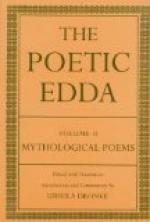The Anglo-Saxon and German agree on another point where both differ from the Norse. The Anglo-Saxon poem Deor is supposed to be spoken by a scop or court poet who has been ousted from the favour of his lord, a Heodening, by Heorrenda, another singer: “Once I was the Heodenings’ scop, dear to my lord: Deor was my name. Many a year I had a good service and a gracious lord, until the song-skilled Hoerrenda received the rights which the protector of men once granted me.” Like Heorrenda, Horant in the Gudrun is a singer in the service of the Heathnings. The Norse version keeps the name, and its connection with the Heathnings, but gives Hjarrandi, as the hero’s father, no active part to play. In both points, arguing from the probable Frisian origin of the story, the Anglo-Saxon and German are more likely to have the correct form.
The legend is, like those of Walter and Hildigund, Helgi and Sigrun, founded on the primary instincts of love and war. In the Norse story of the Heathnings, however, the former element is almost eliminated. It is from no love to Hedin that Hild accompanies him, though Saxo would have it so. Nothing is clearer than that strife is her only object. It is her mediation which brings about the battle, when apparently both heroes would be quite willing to make peace; and her arts which cause the daily renewal of fighting. This island battle among dead and living is peculiar to the Norse version, and coloured by, if not originating in, the Valhalla idea: Hoegni and Hedin and their men are the Einherjar who fight every day and rest and feast at night, Hild is a war-goddess. The conception of her character, contrasting with the gentler part played by the Continental German heroines (who are rather the causes than the inciters of strife), can be paralleled from many of the sagas proper.
Hoegni’s sword Dainsleif, forged by the dwarfs, as were all magic weapons, is like the sword of Angantyr, in that it claims a victim whenever it is drawn from the sheath: an idea which may easily have arisen from the prowess of any famous swordsman.
The Sword of Angantyr.—Like the two last legends, Angantyr’s story is not represented in the Elder Edda; it is not even told by Snorri. Yet poems belonging to the cycle survive (preserved by good fortune in the late mythical Hervarar Saga) which among the heroic poems rank next in artistic beauty to the Helgi Lays. Since the story possesses besides a striking originality, and is connected with the name of a Pan-Germanic hero, the Ongendtheow of Old English poetry, I cannot follow the example of most editors and omit it from the heroic poems.
Like the Volsung legend it is the story of a curse; and there is a general similarity of outline, with the exception that the hero is in this case a woman. The curse-laden treasure is here the sword Tyrfing, which Svafrlami got by force from the dwarfs. They laid a curse on it: that it should bring death to its bearer, no wound it made should be healed, and it should claim a victim whenever it was unsheathed. In the saga, the story is spread over several generations: partly, no doubt, in order to include varying versions; partly also in imitation of the true Icelandic family saga. The chief actors in the legend, beside the sword, are Angantyr and his daughter Hervoer.




